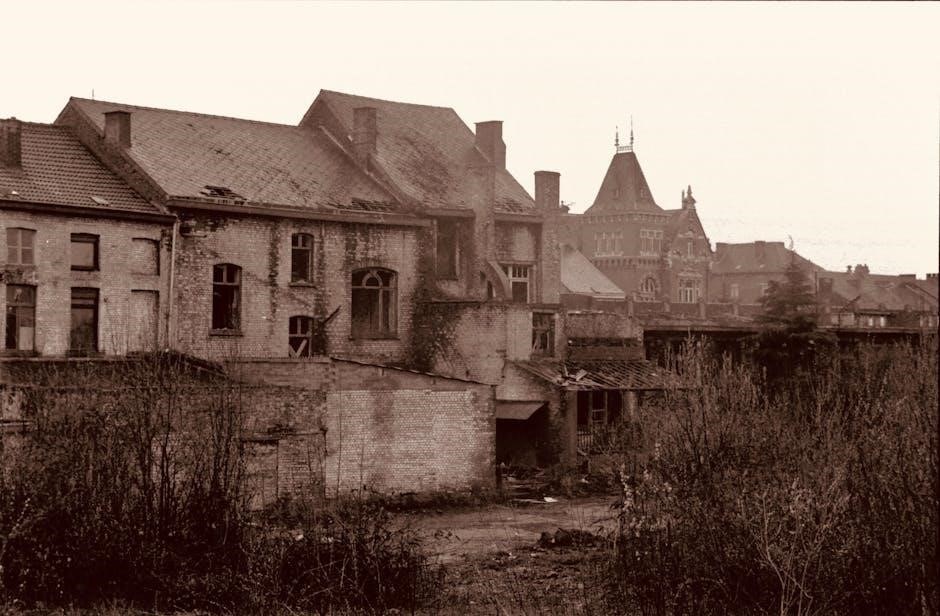
The Allied bombings of Rouen during World War II were a series of strategic airstrikes targeting German-occupied France. Rouen, a key urban and industrial hub, faced significant destruction and civilian casualties, shaping its wartime history and post-war reconstruction efforts.
1.1 Historical Context of Rouen During World War II

Rouen, a historic city in Normandy, was occupied by German forces in 1940, becoming a strategic hub for Nazi operations. Its industrial and logistical significance made it a prime target for Allied bombing campaigns. The city endured relentless bombardments in 1944, aimed at weakening German supply lines and paving the way for the liberation of Normandy. Civilians bore the brunt of the destruction, with widespread casualties and infrastructure collapse, marking a dark chapter in Rouen’s wartime history.
1.2 The Significance of Rouen as a Strategic Target
Rouen’s strategic importance stemmed from its role as a major transportation and industrial center. The city’s port and rail networks were crucial for German troop movements and supply distribution. Allied forces targeted Rouen to disrupt these operations, aiming to weaken the enemy’s grip on Normandy. Its industrial facilities, including armaments and munitions plants, were key to the German war effort, making Rouen a high-priority target for Allied bombardments during World War II.
The Allied Bombing Campaigns in 1944
The Allied bombing campaigns in 1944 targeted Rouen’s infrastructure and industrial zones. Anglo-American forces conducted systematic raids, notably on May 30 and 31, dropping over 1,500 tons of bombs.
2.1 The Role of Anglo-American Forces in the Bombardments
The Anglo-American forces played a pivotal role in the 1944 bombardments of Rouen, executing precision raids to disrupt German supply lines and communication networks. British and American bombers targeted railways, bridges, and industrial sites, weakening the enemy’s logistical capabilities. These operations were part of a broader strategy to prepare for the liberation of Normandy, showcasing the Allies’ coordinated efforts to regain control of occupied territories. The bombings underscored the significance of Rouen as a strategic hub.
2.2 Key Dates and Major Bombing Raids on Rouen
In 1944, Rouen experienced intensified Allied bombing raids, particularly in April and May, targeting railway hubs and industrial sites. These operations resulted in significant civilian casualties, with 883 reported deaths. The bombings caused extensive damage to infrastructure, disrupting German supply lines and communication networks. These raids were crucial in weakening enemy logistical capabilities, aligning with the Allies’ broader strategic objectives in Normandy.
Impact of the Bombings on Civilians and Infrastructure
The Allied bombings caused severe civilian casualties and infrastructure destruction in Rouen. Over 800 deaths were reported, with widespread damage to homes, railways, and industrial sites, leading to a humanitarian crisis and long-term economic repercussions.
3.1 Civilian Casualties and Humanitarian Crisis
The Allied bombings of Rouen resulted in significant civilian casualties, with over 800 deaths reported in 1944. The attacks caused widespread destruction of residential areas, displacing thousands and creating a severe humanitarian crisis. Essential services were disrupted, leading to shortages of food, water, and medical care. The bombings exacerbated the suffering of the local population, already enduring the hardships of war, and left lasting scars on the community and its infrastructure.
3.2 Destruction of Infrastructure and Economic Consequences
The Allied bombings of Rouen caused extensive damage to infrastructure, including roads, bridges, and industrial facilities. Key economic sectors, such as manufacturing and transportation, were severely disrupted, leading to long-term financial repercussions. The destruction of vital infrastructure hindered post-war recovery efforts and impacted the region’s economic stability for years. These losses compounded the humanitarian crisis, creating a challenging environment for rebuilding and revitalizing the city after the war.
Allied Strategic Objectives Behind the Bombardments
The Allied bombings of Rouen aimed to disrupt German supply lines, weaken communication networks, and prepare for the liberation of Normandy by targeting key industrial and transportation hubs.
4.1 Weakening German Supply Lines and Communication
The Allied bombings of Rouen specifically targeted German supply lines and communication networks. By destroying key infrastructure like railways, roads, and bridges, the Allies aimed to sever the logistical support essential for German troop movements and coordination. This strategic focus was crucial in disrupting enemy operations and preparing for the broader liberation efforts in Normandy, ultimately weakening the German army’s ability to respond effectively.
4.2 Preparing for the Liberation of Normandy
The Allied bombings of Rouen played a pivotal role in preparing for the liberation of Normandy. By targeting German military installations, airfields, and transportation hubs, the Allies sought to neutralize enemy strongpoints and create favorable conditions for ground forces. This strategic campaign significantly weakened German defenses, ensuring a smoother advance during the D-Day operations and subsequent liberation efforts, which were critical to the ultimate Allied victory in Western Europe.

Post-War Reconstruction and Memorialization
Post-war Rouen underwent extensive reconstruction, rebuilding infrastructure and historic sites devastated by bombings. Memorials were erected to honor civilian victims, preserving the city’s wartime memory and resilience.
5.1 Efforts to Rebuild Rouen After the War
Post-war Rouen faced massive reconstruction challenges due to extensive damage from Allied bombings. Efforts focused on restoring infrastructure, historic landmarks, and essential services. The city prioritized rebuilding residential areas and industrial sites to revive the economy. Local authorities and international aid played crucial roles in revitalizing the community and preserving its cultural heritage, ensuring Rouen’s recovery and future growth.
5.2 Commemoration of the Bombings in Modern Rouen
In modern Rouen, the bombings are commemorated through memorials and public exhibitions. The city honors the victims and acknowledges the historical impact. Annual events and educational programs ensure the memory of the bombings remains alive. These efforts promote peace while preserving Rouen’s wartime history for future generations to understand and reflect on the sacrifices made during World War II.

Propaganda and Public Perception
The Allied bombings of Rouen were heavily influenced by propaganda. Axis forces portrayed the attacks as indiscriminate, while Allies justified them as necessary for liberation, shaping public opinion and wartime narratives.
6.1 Axis Propaganda About the Bombardments
Axis propaganda portrayed Allied bombings of Rouen as indiscriminate terror tactics, emphasizing civilian casualties and destruction. Nazi-controlled media labeled the attacks as “terror from the sky,” aiming to sway public opinion against the Allies. This narrative highlighted the suffering of innocent civilians, framing the bombings as morally reprehensible. Such propaganda sought to undermine Allied legitimacy while fostering sympathy for the Axis cause during World War II.
6.2 Allied Justification for the Bombing Campaign
The Allies justified the bombing campaign as a strategic necessity to weaken German forces and prepare for Normandy’s liberation. Targeting infrastructure like railways and bridges aimed to disrupt enemy supply lines and communication, crucial for advancing troops. The Allies emphasized the military importance of Rouen, framing the bombings as a vital step toward ending the war and freeing occupied Europe from Nazi control, despite the tragic civilian cost.

Accessing Historical Documents and PDF Resources
Archival sources and PDFs on the Allied bombings of Rouen are accessible through historical databases, libraries, and online repositories. Researchers can explore military records and wartime correspondence for detailed insights into the events and their impact.
7.1 Archival Sources and Historical Records
Archival sources on the Allied bombings of Rouen are found in national archives, military repositories, and local libraries. Historical records include logbooks, correspondence, and photographs documenting the events. Researchers can access these materials through institutions like the National Archives of France and the Imperial War Museum. Digital platforms also provide scanned documents, offering insights into the planning and execution of the bombing campaigns, as well as their impact on the city and its inhabitants.
7.2 Recommended PDFs for Further Reading
For in-depth analysis, several PDFs offer detailed insights into the Allied bombings of Rouen. Academic papers from universities and historical societies provide primary sources, eyewitness accounts, and strategic analyses. Titles such as “The Allied Bombing Campaigns in Normandy” and “Rouen Under Fire: 1944 Bombardments” are invaluable resources. These documents, accessible through online archives and academic databases, shed light on the military tactics and humanitarian impact of the bombings, offering a comprehensive understanding of this pivotal event.
The Allied bombings of Rouen in 1944 significantly impacted the city, causing civilian casualties and infrastructure destruction. The legacy of these events remains a crucial part of Rouen’s history.
8.1 The Legacy of the Allied Bombings on Rouen

The Allied bombings of Rouen left a lasting impact on the city’s identity and culture. Civilian casualties and infrastructure destruction shaped post-war reconstruction efforts, fostering resilience and unity among residents. The bombings are remembered as a pivotal moment in Rouen’s history, with memorials and commemorations honoring the victims and highlighting the city’s path to recovery and renewal after World War II.
8.2 Lessons Learned from the Bombardments
The Allied bombings of Rouen underscored the importance of balancing strategic military objectives with humanitarian concerns. Civilian casualties and infrastructure destruction highlighted the need for precise targeting and minimizing collateral damage. These events also emphasized the importance of post-war reconstruction and memorialization to honor victims and rebuild communities. The bombings remain a critical case study in the ethical and logistical challenges of modern warfare, influencing future military strategies and international policies.

References and Further Research
Key sources include historical archives, academic studies, and eyewitness accounts. PDFs like “Bombardements 1944” by Overy and “Rouen Under Siege” offer detailed insights into the bombings and their impact.
9.1 Key Historians and Their Contributions
Historians like Richard Overy and Antony Beevor have extensively documented the Allied bombings of Rouen. Their works provide critical analyses of the strategic motives and human toll, offering comprehensive insights into the events. Overy’s research highlights the broader context of Allied bombing campaigns, while Beevor focuses on the operational details and civilian impact. Their contributions remain essential for understanding this chapter of WWII history.
9.2 Suggested Topics for Deeper Exploration
Exploring the long-term psychological impact on survivors and the reconstruction challenges provides deeper insights. Comparing Rouen’s experience with other bombed cities offers a broader perspective. Examining the ethical debates surrounding civilian targeting and the strategic effectiveness of the bombings is crucial. Additionally, studying the role of local resistance movements and their interactions with Allied forces could uncover untold stories, enriching the historical narrative of this pivotal event.